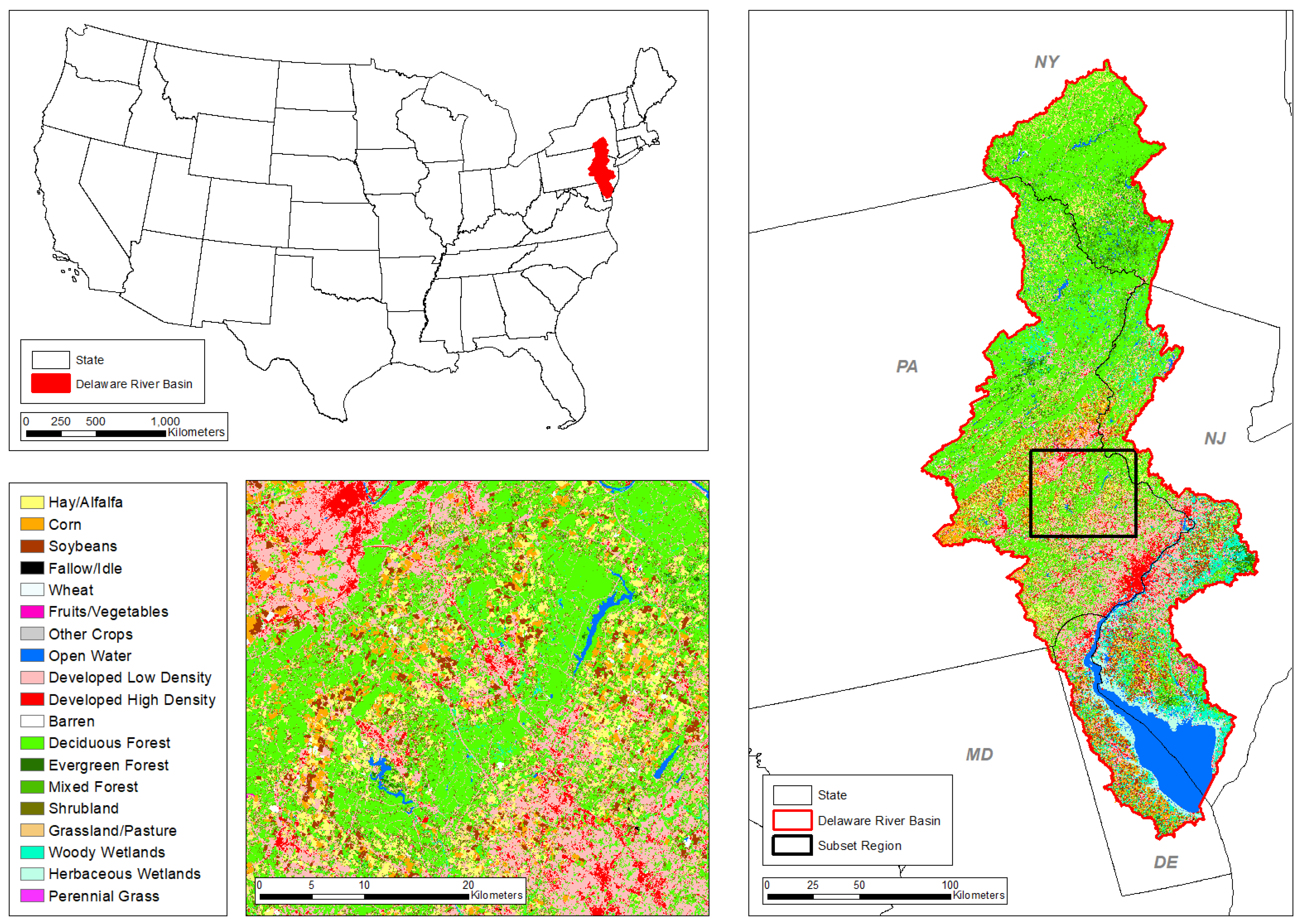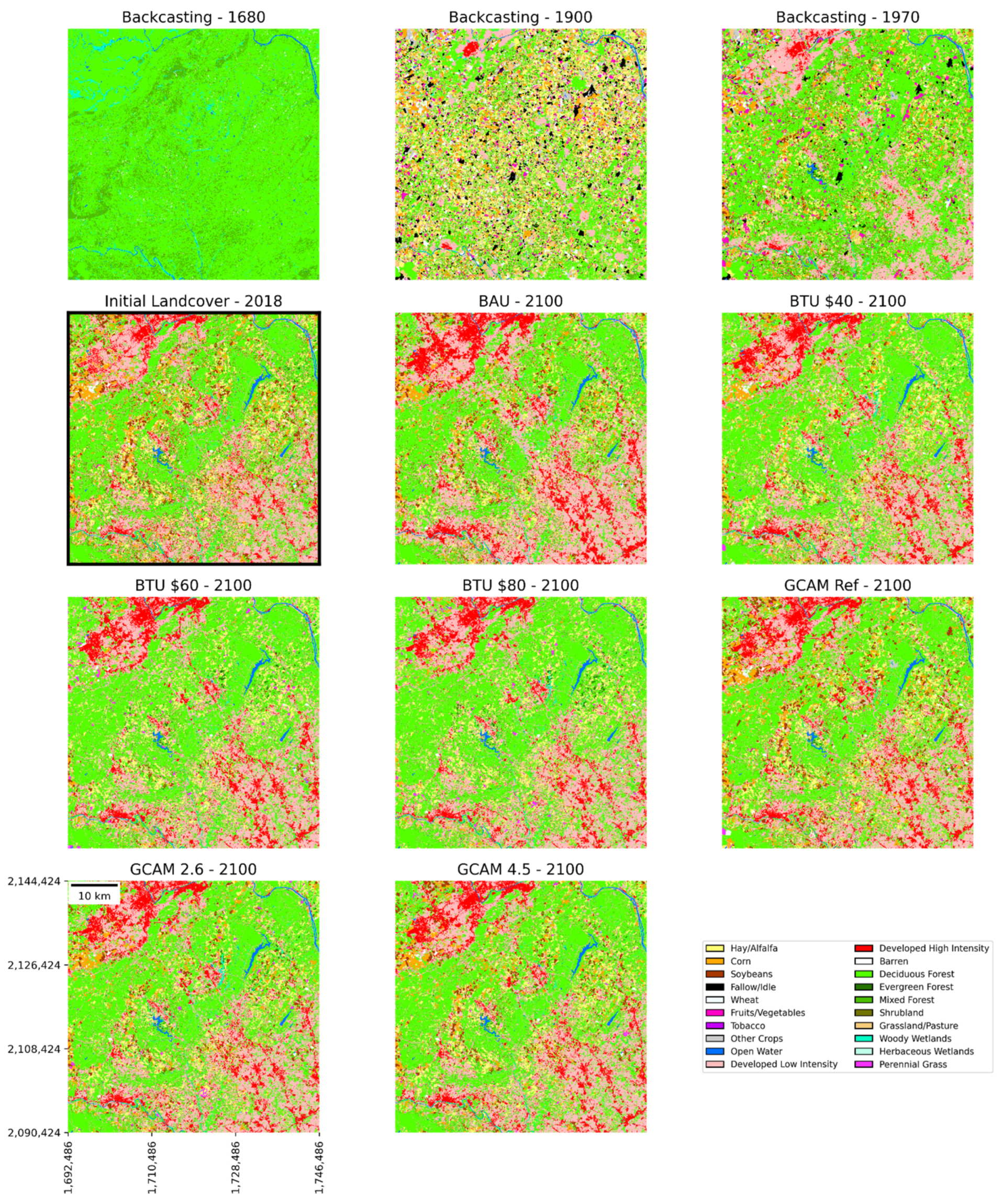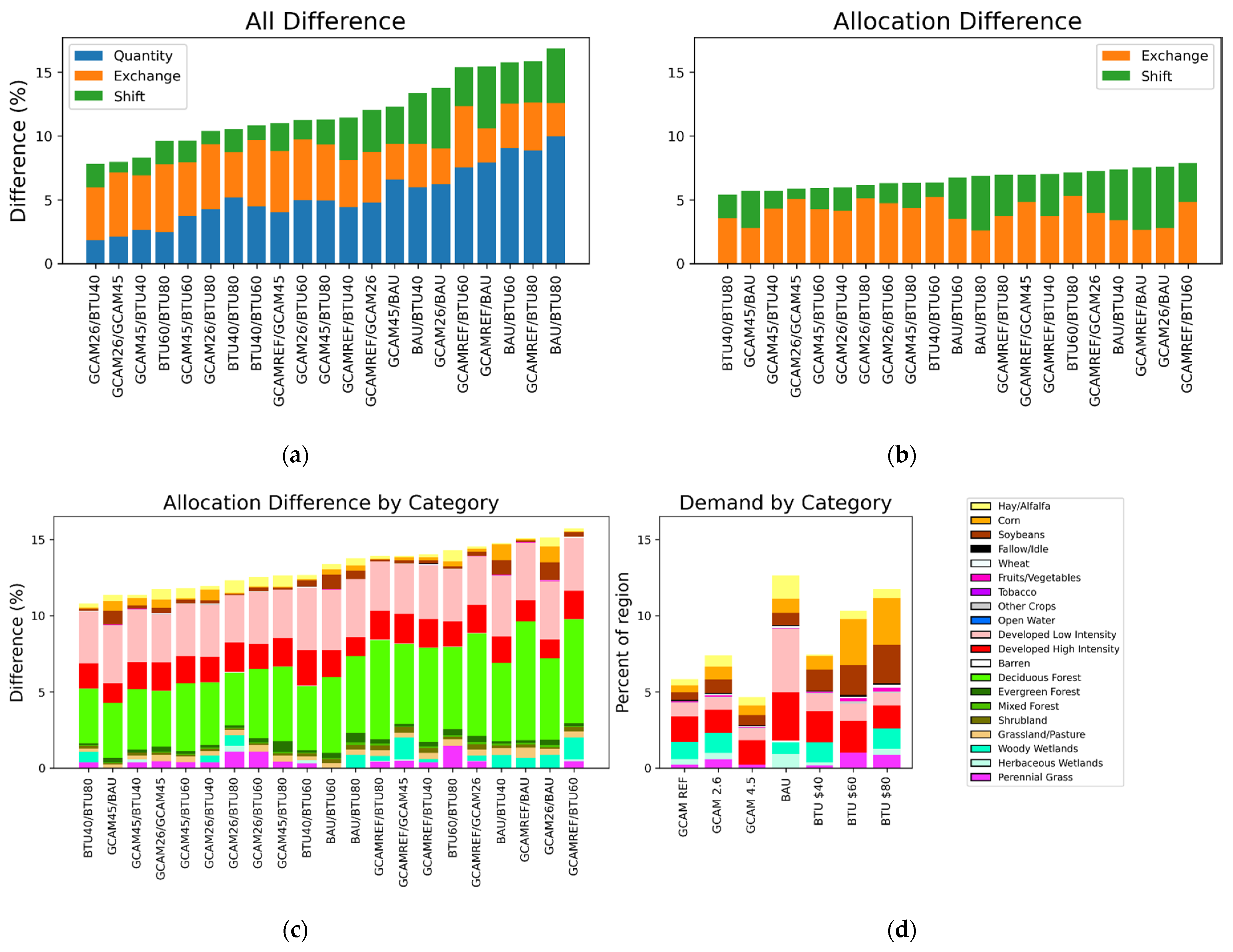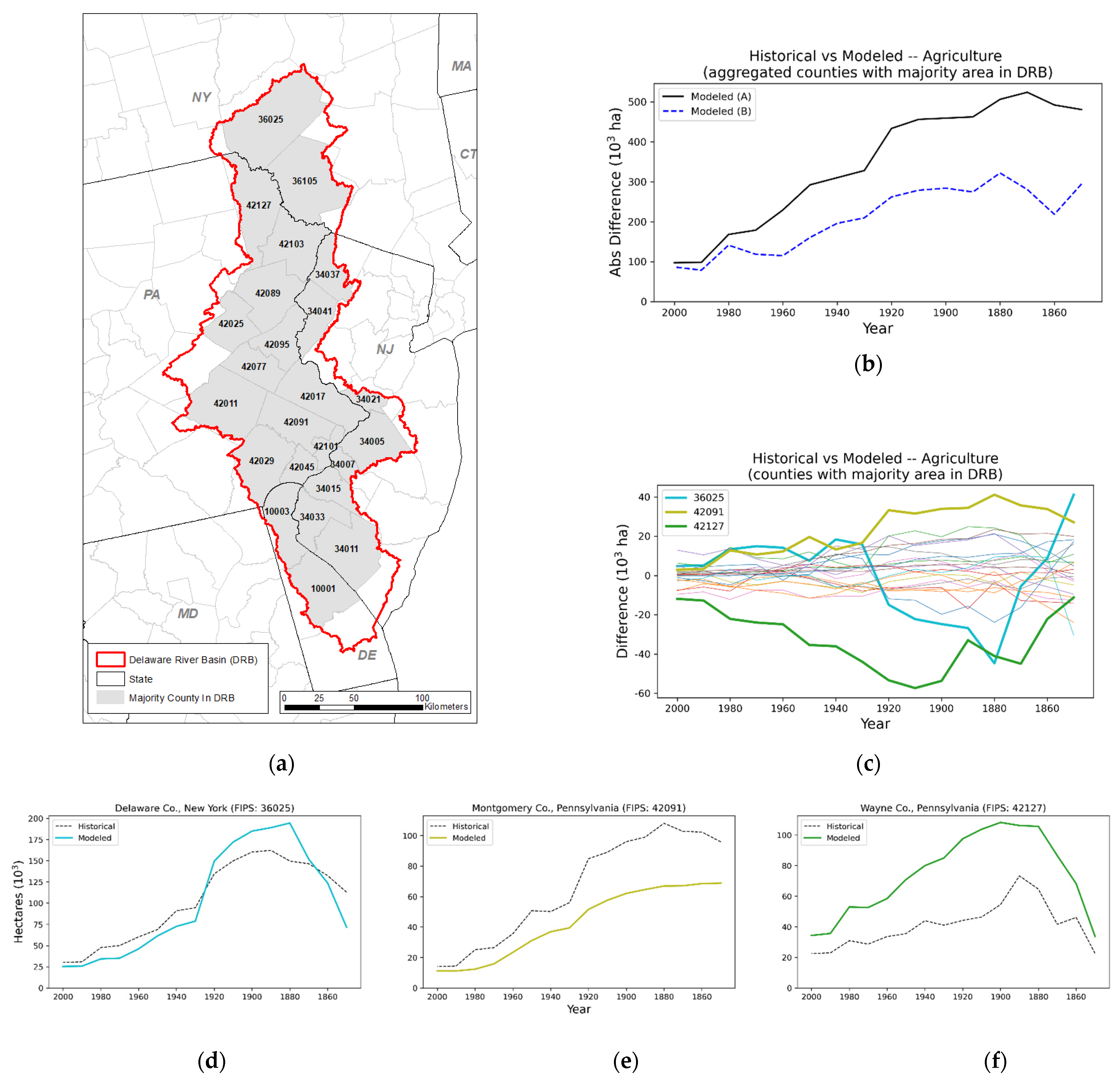Author Contributions
Conceptualization, T.S.; methodology, T.S. and J.D.; software, S.W. and J.D.; validation, J.D.; data curation, C.R.; writing—original draft preparation, J.D., T.S. and G.R.; writing—review and editing, T.S., J.D., and G.R.; visualization, J.D.; supervision, T.S.; funding acquisition, T.S. All authors have read and agreed to the published version of the manuscript.
Figure 1.
Clockwise from top-left: Delaware River Basin (DRB) study area in the conterminous US; the study area intersects the states of New York, Delaware, New Jersey, Pennsylvania, and Maryland; subset region referenced below (
Section 2.4.2 and
Section 3.2).
Figure 1.
Clockwise from top-left: Delaware River Basin (DRB) study area in the conterminous US; the study area intersects the states of New York, Delaware, New Jersey, Pennsylvania, and Maryland; subset region referenced below (
Section 2.4.2 and
Section 3.2).
Figure 2.
54 km × 54 km region (introduced
Figure 1; axes units are projected coordinates in meters) demonstrating (
a) presence of the category Corn in the starting land cover; (
b) corresponding likelihood/suitability values; (
c) TOC curve derived from presence and suitability over the entire region; (
d) histogram (pixel counts vs. values) for suitability values corresponding with initial presence; (
e) histogram showing pixels selected from all available (green) for potential landscape expansion of Corn under old (pink) and new (brown) methods.
Figure 2.
54 km × 54 km region (introduced
Figure 1; axes units are projected coordinates in meters) demonstrating (
a) presence of the category Corn in the starting land cover; (
b) corresponding likelihood/suitability values; (
c) TOC curve derived from presence and suitability over the entire region; (
d) histogram (pixel counts vs. values) for suitability values corresponding with initial presence; (
e) histogram showing pixels selected from all available (green) for potential landscape expansion of Corn under old (pink) and new (brown) methods.
Figure 3.
(a) Urban land cover logistic growth curves fit HISDAC, Census ACS, and Census population data. Urban areas for HISDAC and Census ACS series are given by the right vertical axis. The population series uses the left vertical axis. Logistic curve growth rates provided in parentheses are not dependent on y-units. (b) Harmonized, weighted growth curve with remote-sensing-based urban land cover estimates and historical urban estimates from digitized topographic maps.
Figure 3.
(a) Urban land cover logistic growth curves fit HISDAC, Census ACS, and Census population data. Urban areas for HISDAC and Census ACS series are given by the right vertical axis. The population series uses the left vertical axis. Logistic curve growth rates provided in parentheses are not dependent on y-units. (b) Harmonized, weighted growth curve with remote-sensing-based urban land cover estimates and historical urban estimates from digitized topographic maps.
Figure 4.
Modeled quantities for the aggregated land cover categories Agriculture (Hay/Alfalfa, Corn, Soybeans, Wheat, Fallow/Idle, Fruits/Vegetables, Perennial Grass, and Other Crops, top), Urban (Developed Low Intensity and Developed High Intensity, middle), and Forest (Deciduous, Evergreen, and Mixed, bottom). Backcasting/forecasting (left) panels cover the entire time series—1680 to 2100. Forecasting (right) panels reduce time series to projections—2018 to 2100. The “no change” baselines represent initial (2018) quantities. Respectively, the aggregated categories Agriculture, Urban, and Forest represent 14%, 20%, and 49% of the total region in 2018.
Figure 4.
Modeled quantities for the aggregated land cover categories Agriculture (Hay/Alfalfa, Corn, Soybeans, Wheat, Fallow/Idle, Fruits/Vegetables, Perennial Grass, and Other Crops, top), Urban (Developed Low Intensity and Developed High Intensity, middle), and Forest (Deciduous, Evergreen, and Mixed, bottom). Backcasting/forecasting (left) panels cover the entire time series—1680 to 2100. Forecasting (right) panels reduce time series to projections—2018 to 2100. The “no change” baselines represent initial (2018) quantities. Respectively, the aggregated categories Agriculture, Urban, and Forest represent 14%, 20%, and 49% of the total region in 2018.
Figure 5.
From top-left to bottom-right: Backcasting at 1680, 1900, and 1970, starting land cover (boxed in black), and all forecast scenarios (BAU, BTU, GCAM) at the year 2100 for the same 54 km × 54 km area from
Figure 1.
Figure 5.
From top-left to bottom-right: Backcasting at 1680, 1900, and 1970, starting land cover (boxed in black), and all forecast scenarios (BAU, BTU, GCAM) at the year 2100 for the same 54 km × 54 km area from
Figure 1.
Figure 6.
Measures of difference (quantity, exchange, and shift) for all modeled forecasting scenario combinations and all forecasting years.
Figure 6.
Measures of difference (quantity, exchange, and shift) for all modeled forecasting scenario combinations and all forecasting years.
Figure 7.
Difference between modeled scenario combinations for the year 2100 for (a) all components of difference (quantity, exchange, and shift); (b) spatial allocation difference (exchange and shift); (c) spatial allocation difference by land cover category; (d) cumulative (2020–2100) absolute (positive and negative) prescribed change by scenario and land cover category.
Figure 7.
Difference between modeled scenario combinations for the year 2100 for (a) all components of difference (quantity, exchange, and shift); (b) spatial allocation difference (exchange and shift); (c) spatial allocation difference by land cover category; (d) cumulative (2020–2100) absolute (positive and negative) prescribed change by scenario and land cover category.
Figure 8.
Comparisons of modeled (solid orange) quantities and prescribed demand (dashed black) for all categories and years of historical backcasting. (Note: demand for “flexible” categories is represented by initial (2018) quantities.).
Figure 8.
Comparisons of modeled (solid orange) quantities and prescribed demand (dashed black) for all categories and years of historical backcasting. (Note: demand for “flexible” categories is represented by initial (2018) quantities.).
Figure 9.
(a) Counties with majority area inside the study area; (b) time series for model runs both without (A) and with (B) incorporation of historical dataset plotting the absolute difference in area (hectares) between modeled and historical land-in-agriculture summed for counties with majority area inside the study region; (c) county-level disagreement with historical cropland; (d–f) modeled agriculture vs. historical for the three counties with the most disagreement with historical cropland data.
Figure 9.
(a) Counties with majority area inside the study area; (b) time series for model runs both without (A) and with (B) incorporation of historical dataset plotting the absolute difference in area (hectares) between modeled and historical land-in-agriculture summed for counties with majority area inside the study region; (c) county-level disagreement with historical cropland; (d–f) modeled agriculture vs. historical for the three counties with the most disagreement with historical cropland data.
Figure 10.
Urban land cover footprint modeled for Philadelphia area for the year 1900 (a) without incorporation of BUI and (b) with incorporation of BUI; (c) reference BUI for Philadelphia area, year 1900; (d) time series for model run (C), which did not use BUI in the urban module, and model run (D), which did use BUI in the urban module; (e) time series of BUI autocorrelation; (f) time series demonstrating rural population proportion change for the DRB.
Figure 10.
Urban land cover footprint modeled for Philadelphia area for the year 1900 (a) without incorporation of BUI and (b) with incorporation of BUI; (c) reference BUI for Philadelphia area, year 1900; (d) time series for model run (C), which did not use BUI in the urban module, and model run (D), which did use BUI in the urban module; (e) time series of BUI autocorrelation; (f) time series demonstrating rural population proportion change for the DRB.
Figure 11.
Comparison of FORE-SCE and LUH2 modeled LULC from 1680–2100 in the DRB for major categories (a,b) Agriculture; (c,d) Urban; and (e,f) Forest.
Figure 11.
Comparison of FORE-SCE and LUH2 modeled LULC from 1680–2100 in the DRB for major categories (a,b) Agriculture; (c,d) Urban; and (e,f) Forest.
Table 1.
Thematic land cover classes modeled for the Delaware River Basin (DRB). Classes represent a majority of National Land Cover Database (NLCD) 2016 classes, with major crop types from the US Department of Agriculture (USDA) Cropland Data Layer (CDL). Change type refers to spatial allocation method enacting landscape change.
Table 1.
Thematic land cover classes modeled for the Delaware River Basin (DRB). Classes represent a majority of National Land Cover Database (NLCD) 2016 classes, with major crop types from the US Department of Agriculture (USDA) Cropland Data Layer (CDL). Change type refers to spatial allocation method enacting landscape change.
| Thematic Class | Description | Change Type |
|---|
| Hay/Alfalfa 1 | Areas of grasses, legumes, or grass-legume mixtures planted for livestock grazing or the production of seed or hay crops, typically on a perennial cycle. Hay/alfalfa vegetation accounts for greater than 20% of total vegetation. | Parcel |
| Corn 1 | Cropland areas comprised primarily of corn. | Parcel |
| Soybeans 1 | Cropland areas comprised primarily of soybeans. | Parcel |
| Fallow/Idle 1 | Cropland areas comprised primarily of fallow and idle lands. | Parcel |
| Wheat 1 | Cropland areas comprised primarily of wheat. | Parcel |
| Fruits/Vegetables 1 | Cropland areas comprised primarily of fruit and vegetable crops. Represents an aggregate of fruit and vegetable classes from the Cropland Data Layer. | Parcel |
| Tobacco 1 | Cropland areas comprised primarily of tobacco. | Parcel |
| Other Crops 1 | Cropland areas comprised of crop types not represented in classes 1–7 above. | Parcel |
| Open Water 2 | Areas of open water, generally with less than 25% cover of vegetation or soil. | Pre-defined Patch |
| Developed Low Intensity 2 | Representing NLCD classes “Developed-Open Space” and “Developed-Low Intensity”, areas where impervious surfaces account for 0 to 49% of total cover. Includes single family housing units, parks, golf courses, and other recreational urban settings. | Parcel and Random Patch |
| Developed Med-High Intensity 2 | Representing NLCD classes “Developed-Medium Intensity” and “Developed-High Intensity”, areas where impervious surfaces account for 50–100% of total cover. Includes dense single-family housing units, apartment complexes, and commercial/industrial areas. | Parcel and Random Patch |
| Barren 2 | Areas of bedrock, desert pavement, scarps, talus, slides, volcanic material, glacial debris, sand dunes, strip mines, gravel pits, and other accumulations of earthen material. Generally, vegetation accounts for less than 15% of total cover. | Pixel |
| Deciduous Forest 2 | Areas dominated by trees generally greater than 5 m tall, and greater than 20% of total vegetation cover. More than 75% of the tree species shed foliage simultaneously in response to seasonal change. | Pixel |
| Evergreen Forest 2 | Areas dominated by trees generally greater than 5 m tall, and greater than 20% of total vegetation cover. More than 75% of the tree species maintain their leaves all year. Canopy is never without green foliage. | Pixel |
| Mixed Forest 2 | Areas dominated by trees generally greater than 5 m tall, and greater than 20% of total vegetation cover. Neither deciduous nor evergreen species are greater than 75% of total tree cover. | Pixel |
| Shrubland 2 | Areas dominated by shrubs; less than 5 m tall with shrub canopy typically greater than 20% of total vegetation. This class includes true shrubs, young trees in an early successional stage, or trees stunted from environmental conditions. | Pixel |
| Grassland/Pasture 2 | Areas dominated by graminoid or herbaceous vegetation, generally greater than 80% of total vegetation. These areas are not subject to intensive management such as tilling but can be utilized for grazing. | Parcel |
| Woody Wetlands 2 | Areas where forest or shrubland vegetation accounts for greater than 20% of vegetative cover and the soil or substrate is periodically saturated with or covered with water. | Pixel |
| Herbaceous Wetlands 2 | Areas where perennial herbaceous vegetation accounts for greater than 80% of vegetative cover and the soil or substrate is periodically saturated with or covered with water. | Pixel |
| Perennial Grasses 3 | Areas where perennial grasses used for the production of cellulosic-based biofuel represent greater than 80% of total vegetation. | Parcel |
Table 2.
Forecasting scenarios developed for the DRB.
Table 2.
Forecasting scenarios developed for the DRB.
| Forecasting Scenario | Acronym | Description |
|---|
| Business-as-Usual | BAU
| Extrapolation of existing trends in 2001–2016 NLCD and 2008–2018 CDL.
|
| Billion Ton Update, $40 Farmgate | BTU $40 | US Department of Energy (DOE) scenario for national biomass production >= 1 billion tons assuming farmgate price of USD 40/ton for dry biomass. |
| Billion Ton Update, $60 Farmgate | BTU $60 | US DOE scenario for national biomass production >= 1 billion tons assuming farmgate price of USD 60/ton for dry biomass. |
| Billion Ton Update, $80 Farmgate | BTU $80 | US DOE scenario for national biomass production >= 1 billion tons assuming farmgate price of USD 80/ton for dry biomass. |
| Global Change Assessment, no mitigation | GCAM Ref | Global Change and Assessment Model land cover projections assuming no climate change mitigation. |
| Global Change Assessment, mitigation pathway 2.6 | GCAM 2.6 | Global Change and Assessment Model land cover projections assuming mitigation in line with Representative Concentration Pathway (RCP) 2.6 framework. |
| Global Change Assessment, mitigation pathway 4.5 | GCAM 4.5 | Global Change and Assessment Model land cover projections assuming mitigation in line with RCP 4.5 framework. |
Table 3.
Gross prescribed change (both positive and negative) and absolute deviation from prescribed change aggregated over all backcast years, separated into categories with explicitly supplied demand.
Table 3.
Gross prescribed change (both positive and negative) and absolute deviation from prescribed change aggregated over all backcast years, separated into categories with explicitly supplied demand.
| | Backcasting |
|---|
| Total Gross Demand (ha) | 3,579,796 |
| Total Gross Deviation (%) | 0.94 |
| Hay/Alfalfa | 0.16 |
| Corn | 0.05 |
| Soybeans | 0.00 |
| Fallow/Idle | 0.04 |
| Wheat | 0.07 |
| Fruits/Vegetables | 0.08 |
| Other Crops | 0.13 |
| Grassland/Pasture | 0.39 |
| Herbaceous Wetlands | <0.01 |
| Perennial Grass | <0.01 |
Table 4.
Gross prescribed change (both positive and negative) and absolute deviation from prescribed change aggregated over all forecast years, separated into categories with explicitly supplied demand.
Table 4.
Gross prescribed change (both positive and negative) and absolute deviation from prescribed change aggregated over all forecast years, separated into categories with explicitly supplied demand.
| | BAU | BTU $40 | BTU $60 | BTU $80 | GCAM Ref | GCAM 2.6 | GCAM 4.5 |
|---|
| Total Gross Demand (ha) | 419,457 | 249,332 | 345,830 | 394,145 | 222,392 | 263,244 | 183,015 |
| Total Gross Deviation (%) | 0.16 | 0.56 | 0.36 | 0.26 | 1.12 | 0.55 | 0.61 |
| Hay/Alfalfa | 0.01 | 0.02 | 0.02 | 0.01 | 0.35 | 0.03 | 0.03 |
| Corn | 0.02 | 0.03 | 0.02 | 0.02 | 0.18 | 0.04 | 0.04 |
| Soybeans | 0.03 | 0.03 | 0.05 | 0.02 | 0.12 | 0.08 | 0.03 |
| Fallow/Idle | <0.01 | 0.11 | 0.02 | 0.01 | 0.06 | <0.01 | 0.01 |
| Wheat | 0.01 | 0.08 | 0.02 | 0.01 | 0.04 | 0.04 | 0.04 |
| Fruits/Vegetables | 0.02 | 0.08 | 0.01 | 0.01 | 0.06 | 0.03 | 0.05 |
| Other Crops | 0.01 | 0.04 | 0.01 | <0.01 | 0.04 | 0.01 | 0.07 |
| Low Density Developed | 0.01 | 0.03 | 0.01 | 0.01 | 0.01 | 0.01 | 0.01 |
| High Density Developed | <0.01 | 0.01 | 0.01 | <0.01 | 0.01 | 0.02 | 0.03 |
| Woody Wetlands | 0.01 | 0.01 | <0.01 | 0.02 | 0.01 | <0.01 | <0.01 |
| Herbaceous Wetlands | 0.05 | 0.01 | <0.01 | 0.01 | 0.02 | 0.01 | <0.01 |
| Perennial Grass | <0.01 | 0.11 | 0.20 | 0.15 | 0.24 | 0.28 | 0.32 |
Table 5.
Agreement and components of disagreement between reference NLCD 2016 and FORE-SCE modeled output for the same year and land cover categories for the DRB.
Table 5.
Agreement and components of disagreement between reference NLCD 2016 and FORE-SCE modeled output for the same year and land cover categories for the DRB.
| Measure | Percent of Region |
|---|
| Agreement | 95.00 |
| Quantity | 0.03 |
| Exchange | 2.52 |
| Shift | 2.45 |
Table 6.
Modeled land cover at 1680 vs. LANDFIRE BPS pre-settlement dataset percent-of-region.
Table 6.
Modeled land cover at 1680 vs. LANDFIRE BPS pre-settlement dataset percent-of-region.
| Category Name | BPS | Modeled 1680 |
|---|
| Hay/Alfalfa | 0.00% | 0.00% |
| Corn | 0.00% | 0.00% |
| Soybeans | 0.00% | 0.00% |
| Fallow/Idle | 0.00% | 0.00% |
| Wheat | 0.00% | 0.00% |
| Fruits/Vegetables | 0.00% | 0.00% |
| Tobacco | 0.00% | 0.00% |
| Other Crops | 0.00% | 0.00% |
| Open Water | 2.90% | 1.96% |
| Developed Low Intensity | 0.00% | 0.00% |
| Developed High Intensity | 0.00% | 0.00% |
| Barren | 0.78% | 0.81% |
| Deciduous Forest | 58.65% | 65.65% |
| Evergreen Forest | 3.77% | 3.61% |
| Mixed Forest | 22.31% | 15.02% |
| Shrubland | 0.06% | 0.91% |
| Grassland/Pasture | 0.61% | 0.27% |
| Woody Wetlands | 10.92% | 8.22% |
| Herbaceous Wetlands | 0.00% | 3.54% |
| Perennial Grass | 0.00% | 0.00% |



















